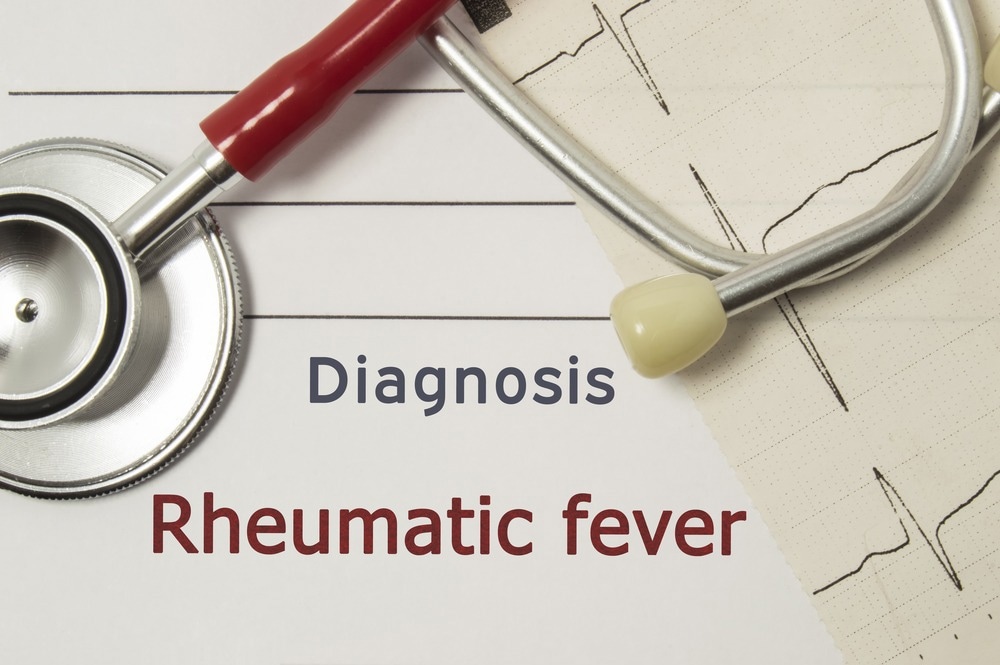Introduction
Jones criteria for rheumatic fever diagnosis
Laboratory studies for rheumatic fever diagnosis
Differential diagnosis
References
Rheumatic fever represents an autoimmune disease following infection with group A streptococcus (Streptococcus pyogenes), one of the most ubiquitous human pathogens. The disease is characterized by multiple focal inflammatory lesions of the connective tissue structures – particularly of the heart, blood vessels, and joints.
Rheumatic fever remains one of the major causes of childhood cardiac disease in developing nations and a serious public health problem worldwide. Hence, adequate diagnosis and management are of utmost importance, as damage to cardiac valves may be chronic and progressive, resulting in cardiac decompensation.

Image Credit: Shidlovski/Shutterstock.com
Jones criteria for rheumatic fever diagnosis
The diagnosis of acute rheumatic fever is established based on identifying major and minor clinical manifestations of the disease, as detailed by the Jones criteria. They were initially published by a physician Thomas Duckett Jones in 1944 and have been revised over the years by the American Heart Association.
Numerous interpretations of these criteria exist, and guidelines can also vary in different settings, most notably in areas where acute rheumatic fever is endemic. The latest revision of the Jones criteria was published by the World Health Organization (WHO) in 2004, also known as the modified Jones criteria.
Evidence of a recent streptococcal infection with at least two major manifestations, or one major and two minor manifestations present, is necessary to diagnose a primary episode of acute rheumatic fever. These criteria can be helpful, as differential diagnosis can be extensive due to the lack of specificity.
Five manifestations are considered major manifestations of acute rheumatic fever: carditis, migratory polyarthritis, Sydenham’s chorea, erythema marginatum, and subcutaneous nodules. The minor manifestations are arthralgias, fever, elevated acute-phase reactants, and first-degree heart block.
It should be emphasized that the principal use of these diagnostic criteria is to help identify rheumatic fever. However, physicians maintain the right to diagnose this condition merely based on clinical judgment, even if the modified criteria are not completely satisfied.
Laboratory studies for rheumatic fever diagnosis
Acute phase reactants are useful in recognizing acute rheumatic fever and excluding other diseases. Certain studies suggest that C-reactive protein and erythrocyte sedimentation rates are commonly elevated in patients with confirmed rheumatic fever (excluding chorea); therefore, they are extremely helpful in monitoring inflammatory activity.
Laboratory evidence of inflammation and a preceding streptococcal infection should be documented – either by demonstrating Streptococcus pyogenes in the throat by culture or using streptococcal antibody tests. Rising titers of antistreptolysin O (ASO) occur in more than 80% of patients with acute pharyngitis.
Prolonged PR interval relative to heart rate on electrocardiogram represents a nonspecific finding found in more than one-third of the patients. Low-voltage QRS complexes and ST segment changes are sometimes found in pericarditis and pericardial effusion.
Cardiac scanning scintigraphy has been shown to be a reliable technique to distinguish acute from chronic, inactive rheumatic heart disease, whereas endomyocardial biopsy should only be limited to clinical investigation due to its invasiveness. The role of echocardiography in diagnosing valvulitis without auscultatory findings has been debated.
Differential diagnosis
Several diseases should be considered when evaluating a patient with suspected rheumatic fever. Juvenile rheumatoid arthritis and other connective tissue diseases should be excluded, which is often possible as the articular involvement in juvenile rheumatoid arthritis usually lasts longer when compared to rheumatic fever.
Furthermore, systemic lupus erythematosus shares certain similarities with acute rheumatic fever (most notably arthralgia and transient arthritis). In addition, some cases of chorea are mild or atypical and may be confused with motor tics or the involuntary jerks of Gilles de la Tourette syndrome.
References:
- Hahn, R.G., Knox, L.M. and Forman, T.A. (2005). Evaluation of Poststreptococcal Illness. American Family Physician, [online] 71(10), pp.1949–1954. Available at: https://www.aafp.org/pubs/afp/issues/2005/0515/p1949.html [Accessed 3 Aug. 2022].
- Madden S, Kelly L. Update on acute rheumatic fever: it still exists in remote communities. Can Fam Physician. 2009 May;55(5):475-8. PMID: 19439697; PMCID: PMC2682299.
- Australian, R. (2017). RACGP - Rheumatic fever - Identification, management and secondary prevention. [online] Racgp.org.au. Available at: https://www.racgp.org.au/afp/2012/januaryfebruary/rheumatic-fever/.
- Why do I need to get every sore throat checked (2020). Why do I need to get every sore throat checked? [online] Heart Foundation NZ. Available at: https://www.heartfoundation.org.nz/your-heart/heart-conditions/rheumatic-heart-disease.
Further Reading